Intercropping in Rice Farming under the System of Rice Intensification—An Agroecological Strategy for Weed Control, Better Yield, Increased Returns, and Social–Ecological Sustainability
Abstract
1. Introduction
2. Materials and Methods
2.1. Experimental Research Design
2.2. Data Collection
2.3. Laboratory Analysis
2.4. Statistical Analysis
3. Results and Discussion
3.1. Field Experiments
3.1.1. Weed Incidence
3.1.2. Plant Growth Parameters
Plant Height
Number of Tillers
Panicle Length
Spikelet Number Per Panicle
Filled Grains Per Panicle
3.1.3. Rice Yield and Fodder Yield
Rice Yield
Fodder Units
3.1.4. Economic Balance
Work-Hours
Economic Balance Sheet
Disease Incidence in Mushkibudij (Mushk Budji) Rice Landrace
3.2. Pot Experiments
3.2.1. Nutrient Uptake
3.2.2. Chlorophyll Content
3.2.3. Tiller Number
4. Conclusions
Author Contributions
Funding
Institutional Review Board Statement
Informed Consent Statement
Data Availability Statement
Acknowledgments
Conflicts of Interest
Appendix A
| Mean | Standard Deviation | Standard Error | |||||||
|---|---|---|---|---|---|---|---|---|---|
| CFR | SRI | SRIBI | CFR | SRI | SRIBI | CFR | SRI | SRIBI | |
| Plant height (Field 2020) | 101 | 104 | 109 | 1.14 | 1.95 | 1.82 | 0.51 | 0.87 | 0.81 |
| Plant height (Field 2019) | 125 | 119 | 128 | 4.88 | 4.59 | 9.56 | 1.47 | 1.38 | 3.38 |
| Panicle length (Field 2020) | 18 | 22 | 24 | 0.65 | 1.17 | 0.67 | 0.24 | 0.44 | 0.25 |
| Panicle length (Field 2019) | 24 | 22 | 22 | 0.81 | 2.03 | 1.05 | 0.25 | 0.64 | 0.34 |
| Tiller Number (Field 2020) | 12 | 30 | 34 | 1.72 | 2.82 | 2.64 | 0.65 | 1.07 | 0.99 |
| Tiller Number (Field 2019) | 9.5 | n.a. | 26.33 | 2.15 | n.a. | 7.45 | 0.81 | n.a. | 2.82 |
| SNPP (Field 2020) | 70 | 140 | 161 | 3.27 | 8.13 | 7.78 | 1.09 | 2.71 | 2.59 |
| SNPP (Field 2019) | n.a. | 95 | 142 | n.a. | 20.12 | 19.79 | n.a. | 6.70 | 6.59 |
| FGPP (Field 2020) | 52 | 126 | 148 | 6.04 | 4.10 | 9.55 | 2.01 | 1.36 | 3.18 |
| Chlorophyll-A | 9.3 | 9.2 | 13.2 | 0.9 | 2.2 | 1.3 | 0.5 | 1.3 | 0.8 |
| Chlorophyll-B | 3.0 | 2.8 | 4.1 | 0.3 | 0.6 | 0.3 | 0.2 | 0.4 | 0.2 |
| N-content | 0.58 | 0.64 | 0.69 | 0.10 | 0.10 | 0.08 | 0.06 | 0.04 | 0.03 |
| P-content | 0.22 | 0.25 | 0.33 | 0.01 | 0.04 | 0.05 | 0.003 | 0.02 | 0.02 |
| K-content | 2.83 | 2.43 | 2.75 | 0.15 | 0.08 | 0.07 | 0.09 | 0.04 | 0.03 |
References
- Foley, J.A.; Ramankutty, N.; Brauman, K.A.; Cassidy, E.S.; Gerber, J.S.; Johnston, M.; Mueller, N.D.; O’Connell, C.; Ray, D.K.; West, P.C.; et al. Solutions for a cultivated planet. Nature 2011, 478, 337–342. [Google Scholar] [CrossRef]
- Pérez-Escamilla, R. Food Security and the 2015–2030 Sustainable Development Goals: From Human to Planetary Health. Curr. Dev. Nutr. 2017, 1, e000513. [Google Scholar] [CrossRef] [PubMed]
- Foley, J.A.; DeFries, R.; Asner, G.P.; Barford, C.; Bonan, G.; Carpenter, S.R.; Chapin, F.S.; Coe, M.T.; Daily, G.C.; Gibbs, H.K.; et al. Global consequences of land use. Science 2005, 309, 570–574. [Google Scholar] [CrossRef] [PubMed]
- Power, A.G. Ecosystem services and agriculture: Tradeoffs and synergies. Philos. Trans. R. Soc. B Biol. Sci. 2010, 365, 2959–2971. [Google Scholar] [CrossRef] [PubMed]
- Millennium Ecosystem Assessment Ecosystems and Human Well-Being: Synthesis. Available online: https://www.millenniumassessment.org/documents/document.356.aspx.pdf (accessed on 16 May 2021).
- FAO. The State of Food and Agriculture—Climate Change, Agriculture and Food Security. Available online: http://www.fao.org/3/a-i6030e.pdf (accessed on 16 May 2021).
- Chivenge, P.; Angeles, O.; Hadi, B.; Acuin, C.; Connor, M.; Stuart, A.; Puskur, R.; Johnson-Beebout, S. Ecosystem services in paddy rice systems. Role Ecosyst. Serv. Sustain. Food Syst. 2020, 1, 181–201. [Google Scholar] [CrossRef]
- Buresh, R.J.; Reddy, K.R.; Van Kessel, C. Nitrogen transformations in submerged soils. Nitrogen Agric. Syst. 2008, 401–436. [Google Scholar]
- Sander, B.O.; Wassmann, R.; Palao, L.K.; Nelson, A. Climate-based suitability assessment for alternate wetting and drying water management in the Philippines: A novel approach for mapping methane mitigation potential in rice production. Carbon Manag. 2017, 8, 331–342. [Google Scholar] [CrossRef]
- Bambaradeniya, C.; Amerasinghe, F. Biodiversity Associated with the Rice Field Agroecosystem in Asian Countries: A Brief Review. Available online: https://www.iwmi.cgiar.org/publications/iwmi-working-papers/iwmi-working-paper-63/ (accessed on 16 May 2021).
- Gathorne-Hardy, A.; Reddy, D.N.; Venkatanarayana, M.; Harriss-White, B. System of Rice Intensification provides environmental and economic gains but at the expense of social sustainability—A multidisciplinary analysis in India. Agric. Syst. 2016, 143, 159–168. [Google Scholar] [CrossRef]
- FAO. Save and Grow in Practice: Maize, Rice and Wheat. A Guide to Sustainable. Available online: http://www.fao.org/policy-support/tools-and-publications/resources-details/en/c/1263072/ (accessed on 16 May 2021).
- Global Rice Science Partnership (GRiSP). Rice Almanac; International Rice Research Institute: Los Banos, CA, USA, 2013; ISBN 9789712203008. [Google Scholar]
- Mishra, U. Indo-Pak Study Reveals Extensive Arsenic Problem in Punjab Groundwater. Available online: https://www.downtoearth.org.in/news/water/indo-pak-study-reveals-extensive-arsenic-problem-in-punjab-groundwater-62534 (accessed on 16 May 2021).
- Rasool, A.; Farooqi, A.; Masood, S.; Hussain, K. Arsenic in groundwater and its health risk assessment in drinking water of Mailsi, Punjab, Pakistan. Hum. Ecol. Risk Assess. Int. J. 2016, 22, 187–202. [Google Scholar] [CrossRef]
- Mukherjee, A.B.; Bhattacharya, P. Arsenic in groundwater in the Bengal Delta Plain: Slow poisoning in Bangladesh. Environ. Rev. 2001, 9, 189–220. [Google Scholar] [CrossRef]
- Roychowdhury, T.; Uchino, T.; Tokunaga, H.; Ando, M. Arsenic and other heavy metals in soils from an arsenic-affected area of West Bengal, India. Chemosphere 2002, 49, 605–618. [Google Scholar] [CrossRef]
- Arao, T.; Kawasaki, A.; Baba, K.; Mori, S.; Matsumoto, S. Effects of water management on cadmium and arsenic accumulation and dimethylarsinic acid concentrations in Japanese rice. Environ. Sci. Technol. 2009, 43, 9361–9367. [Google Scholar] [CrossRef]
- Harwood, J. Could the adverse consequences of the green revolution have been foreseen? How experts responded to unwelcome evidence. Agroecol. Sustain. Food Syst. 2020, 44, 509–535. [Google Scholar] [CrossRef]
- Bunch, R. Use of Green Manures and Cover Crops with SRI. In Proceedings of the Assessments of the System of Rice Intensification: Proceedings of an International Conference, Sanya, China, 1–4 April 2002; Cornell International Institute for Food, Agriculture and Development: Ithaca, NY, USA, 2002; pp. 184–185. [Google Scholar]
- FAO. FAOSTAT. Statistical Database. Inputs. Available online: http://www.fao.org/faostat/en/ (accessed on 7 May 2020).
- FAO. Investing in Smallholder Agriculture for Food Security. Available online: http://www.fao.org/family-farming/detail/en/c/273868/ (accessed on 16 May 2021).
- IPES-Food. COVID-19 and the Crisis in Food Systems: Symptoms, Causes, and Potential Solutions. Available online: http://www.ipes-food.org/_img/upload/files/COVID-19_CommuniqueEN%282%29.pdf (accessed on 16 May 2021).
- Leippert, F.; Darmaun, M.; Bernoux, M.; Mpheshea, M. The Potential of Agroecology to Build Climate-Resilient Livelihoods and Food Systems. Available online: http://www.fao.org/documents/card/en/c/cb0438en (accessed on 16 May 2021).
- Uphoff, N. Higher Yields with Fewer External Inputs? The System of Rice Intensification and Potential Contributions to Agricultural Sustainability. Int. J. Agric. Sustain. 2003, 1, 38–50. [Google Scholar] [CrossRef]
- Uphoff, N. SRI: An agroecological strategy to meet multiple objectives with reduced reliance on inputs. Agroecol. Sustain. Food Syst. 2017, 41, 825–854. [Google Scholar] [CrossRef]
- Balamatti, A.; Uphoff, N. Experience with the system of rice intensification for sustainable rainfed paddy farming systems in India. Agroecol. Sustain. Food Syst. 2017, 41, 573–587. [Google Scholar] [CrossRef]
- Kassam, A.; Stoop, W.; Uphoff, N. Review of SRI modifications in rice crop and water management and research issues for making further improvements in agricultural and water productivity. Paddy Water Environ. 2011, 9, 163–180. [Google Scholar] [CrossRef]
- Stoop, W.A.; Adam, A.; Kassam, A. Comparing rice production systems: A challenge for agronomic research and for the dissemination of knowledge-intensive farming practices. Agric. Water Manag. 2009, 96, 1491–1501. [Google Scholar] [CrossRef]
- Rao, K.C.; Satyanarayana, V.V.S. System of Rice Intensification Experiences of Farmers in India. Available online: http://www.sri-india.net/documents/Farmersexperiences.pdf (accessed on 16 May 2021).
- Satyanarayana, A.; Thiyagarajan, T.M.; Uphoff, N. Opportunities for water saving with higher yield from the system of rice intensification. Irrig. Sci. 2007, 25, 99–115. [Google Scholar] [CrossRef]
- Ly, P.; Jensen, L.S.; Bruun, T.B.; Rutz, D.; de Neergaard, A. The System of Rice Intensification: Adapted practices, reported outcomes and their relevance in Cambodia. Agric. Syst. 2012, 113, 16–27. [Google Scholar] [CrossRef]
- John, A.; Fielding, M. Rice production constraints and “new” challenges for South Asian smallholders: Insights into de facto research priorities. Agric. Food Secur. 2014, 3, 1–16. [Google Scholar] [CrossRef][Green Version]
- Shennan, C.; Krupnik, T.J.; Baird, G.; Cohen, H.; Forbush, K.; Lovell, R.J.; Olimpi, E.M. Organic and Conventional Agriculture: A Useful Framing? Annu. Rev. Environ. Resour. 2017, 42, 317–346. [Google Scholar] [CrossRef]
- Hazra, K.K.; Swain, D.K.; Bohra, A.; Singh, S.S.; Kumar, N.; Nath, C.P. Organic rice: Potential production strategies, challenges and prospects. Org. Agric. 2018, 8, 39–56. [Google Scholar] [CrossRef]
- Delmotte, S.; Tittonell, P.; Mouret, J.-C.; Hammond, R.; Lopez-Ridaura, S. On farm assessment of rice yield variability and productivity gaps between organic and conventional cropping systems under Mediterranean climate. Eur. J. Agron. 2011, 35, 223–236. [Google Scholar] [CrossRef]
- Wayayok, A.; Soom, M.A.M.; Abdan, K.; Mohammed, U. Impact of Mulch on Weed Infestation in System of Rice Intensification (SRI) Farming. Agric. Agric. Sci. Procedia 2014, 2, 353–360. [Google Scholar] [CrossRef]
- Uphoff, N.; Kassam, A. Agricultural Technologies for Developing Countries: Case Study—“The System of Rice Intensification”. Available online: https://www.europarl.europa.eu/RegData/etudes/etudes/stoa/2009/424734/DG-IPOL-STOA_ET%282009%29424734_EN%28PAR05%29.pdf (accessed on 16 May 2021).
- Noltze, M.; Schwarze, S.; Qaim, M. Understanding the adoption of system technologies in smallholder agriculture: The system of rice intensification (SRI) in Timor Leste. Agric. Syst. 2012, 108, 64–73. [Google Scholar] [CrossRef]
- Dobermann, A. A critical assessment of the system of rice intensification (SRI). Agric. Syst. 2004, 79, 261–281. [Google Scholar] [CrossRef]
- Nawaz, A.; Farooq, M. Weed management in resource conservation production systems in Pakistan. Crop. Prot. 2016, 85, 89–103. [Google Scholar] [CrossRef]
- Liebman, M.; Dyck, E. Crop Rotation and Intercropping Strategies for Weed Management. Ecol. Appl. 1993, 3, 92–122. [Google Scholar] [CrossRef]
- Singh, S.; Ladha, J.K.; Gupta, R.K.; Bhushan, L.; Rao, A.N.; Sivaprasad, B.; Singh, P.P. Evaluation of mulching, intercropping with Sesbania and herbicide use for weed management in dry-seeded rice (Oryza sativa L.). Crop. Prot. 2007, 26, 518–524. [Google Scholar] [CrossRef]
- Kermah, M.; Franke, A.C.; Adjei-Nsiah, S.; Ahiabor, B.D.K.; Abaidoo, R.C.; Giller, K.E. Maize-grain legume intercropping for enhanced resource use efficiency and crop productivity in the Guinea savanna of northern Ghana. Field Crop. Res. 2017, 213, 38–50. [Google Scholar] [CrossRef]
- Stoop, W.A.; Sabarmatee; Pushpalatha, S.; Ravindra, A.; Sen, D.; Prasad, S.C.; Thakur, A.K. Opportunities for ecological intensification: Lessons and insights from the System of rice/crop intensification—Their implications for agricultural research and development approaches. Cab Rev. Perspect. Agric. Vet. Sci. Nutr. Nat. Resour. 2017, 12, 1–19. [Google Scholar] [CrossRef]
- Stoop, W.A. The scientific case for system of rice intensification and its relevance for sustainable crop intensification. Int. J. Agric. Sustain. 2011, 9, 443–455. [Google Scholar] [CrossRef]
- Adhikari, P.; Araya, H.; Aruna, G.; Balamatti, A.; Banerjee, S.; Baskaran, P.; Barah, B.C.; Behera, D.; Berhe, T.; Boruah, P.; et al. System of crop intensification for more productive, resource-conserving, climate-resilient, and sustainable agriculture: Experience with diverse crops in varying agroecologies. Int. J. Agric. Sustain. 2017, 16, 1–28. [Google Scholar] [CrossRef]
- Uphoff, N.; Amod, K.T. An agroecological strategy for adapting to climate change: The system of rice intensification (sri). Sustain. Solut. Food Secur. Combat. Clim. Chang. Adapt. 2019, 229–254. [Google Scholar] [CrossRef]
- Doni, F.; Zain, C.R.C.M.; Isahak, A.; Fathurrahman, F.; Anhar, A.; Mohamad, W.N.W.; Yusoff, W.M.W.; Uphoff, N. A simple, efficient, and farmer-friendly Trichoderma-based biofertilizer evaluated with the SRI Rice Management System. Org. Agric. 2018, 8, 207–223. [Google Scholar] [CrossRef]
- Thakur, A.K.; Mandal, K.G.; Raychaudhuri, S. Impact of crop and nutrient management on crop growth and yield, nutrient uptake and content in rice. Paddy Water Environ. 2020, 18, 139–151. [Google Scholar] [CrossRef]
- Arnon, D.I. Copper Enzyems in Isolated Chloroplasts. Polyphenoloxidase in Beta Vulgaris. Plant. Physiol. 1949, 24, 1–15. [Google Scholar] [CrossRef]
- Doni, F.; Zain, C.R.C.M.; Isahak, A.; Fathurrahman, F.; Sulaiman, N.; Uphoff, N.; Yusoff, W.M.W. Relationships observed between Trichoderma inoculation and characteristics of rice grown under System of Rice Intensification (SRI) vs. conventional methods of cultivation. Symbiosis 2017, 72, 45–59. [Google Scholar] [CrossRef]
- Mishra, A.; Salokhe, V.M. The effects of planting pattern and water regime on root morphology, physiology and grain yield of rice. J. Agron. Crop. Sci. 2010, 196, 368–378. [Google Scholar] [CrossRef]
- Zhu, D.; Cheng, S.; Zhang, Y.; Lin, X. Tillering patterns and the contribution of tillers to grain yield with hybrid rice and wide spacing. In Proceedings of the Assessments of the System of Rice Intensification: Proceedings of an International Conference, Sanya, China, 1–4 April 2002; Cornell International Institute for Food, Agriculture and Development: Ithaca, NY, USA, 2002; pp. 125–131. [Google Scholar]
- Ao, H.; Peng, S.; Zou, Y.; Tang, Q.; Visperas, R.M. Reduction of unproductive tillers did not increase the grain yield of irrigated rice. Field Crop. Res. 2010, 116, 108–115. [Google Scholar] [CrossRef]
- Mishra, A.; Uphoff, N. Morphological and physiological responses of rice roots and shoots to varying water regimes and soil microbial densities. Arch. Agron. Soil Sci. 2013, 59, 705–731. [Google Scholar] [CrossRef]
- Huang, M.; Tian, A.; Chen, J.; Cao, F.; Chen, Y.; Liu, L. Soil bacterial communities in three rice-based cropping systems differing in productivity. Sci. Rep. 2020, 10, 1–5. [Google Scholar] [CrossRef] [PubMed]
- Khan, G.H.; Shikari, A.B.; Vaishnavi, R.; Najeeb, S.; Padder, B.A.; Bhat, Z.A.; Parray, G.A.; Bhat, M.A.; Kumar, R.; Singh, N.K. Marker-assisted introgression of three dominant blast resistance genes into an aromatic rice cultivar Mushk Budji. Sci. Rep. 2018, 8, 1–13. [Google Scholar] [CrossRef] [PubMed]
- Najeeb, S.; Parray, G.A.; Shikari, A.B.; Bhat, Z.A.; Bhat, M.A.; Asif, I.M.; Bhat, S.J.; Shah, A.H.; Ahangar, M.A.; Shafiq, W.A. Revival of Endangered High Valued Mountain Rices of Kashmir Himalayas Through Genetic Purification and In-Situ Conservation. Int. J. Agric. Sci. 2016, 8, 2453–2458. [Google Scholar]
- Dean, R.A.; Talbot, N.J.; Ebbole, D.J.; Farman, M.L.; Mitchell, T.K.; Orbach, M.J.; Thon, M.; Kulkarni, R.; Xu, J.R.; Pan, H.; et al. The genome sequence of the rice blast fungus Magnaporthe grisea. Nature 2005, 434, 980–986. [Google Scholar] [CrossRef]
- Mahesh, P.; Shakywar, R.C.; Dinesh, S.; Singh, S. Prevalence of insect pests, natural enemies and diseases in SRI (System of Rice Intensification) of Rice cultivation in North East Region. Ann. Plant. Prot. Sci. 2012, 20, 375–379. [Google Scholar]
- Tann, H.; Makhonpas, C.; Utthajadee, A.; Soytong, K. Effect of good agricultural practice and organic methods on rice cultivation under the system of rice intensification in Cambodia. Int. J. Agric. Technol. 2012, 8, 289–303. [Google Scholar]
- Thakur, A.K.; Rath, S.; Kumar, A. Performance evaluation of rice varieties under the System of Rice Intensification compared with the conventional transplanting system. Arch. Agron. Soil Sci. 2011, 57, 223–238. [Google Scholar] [CrossRef]
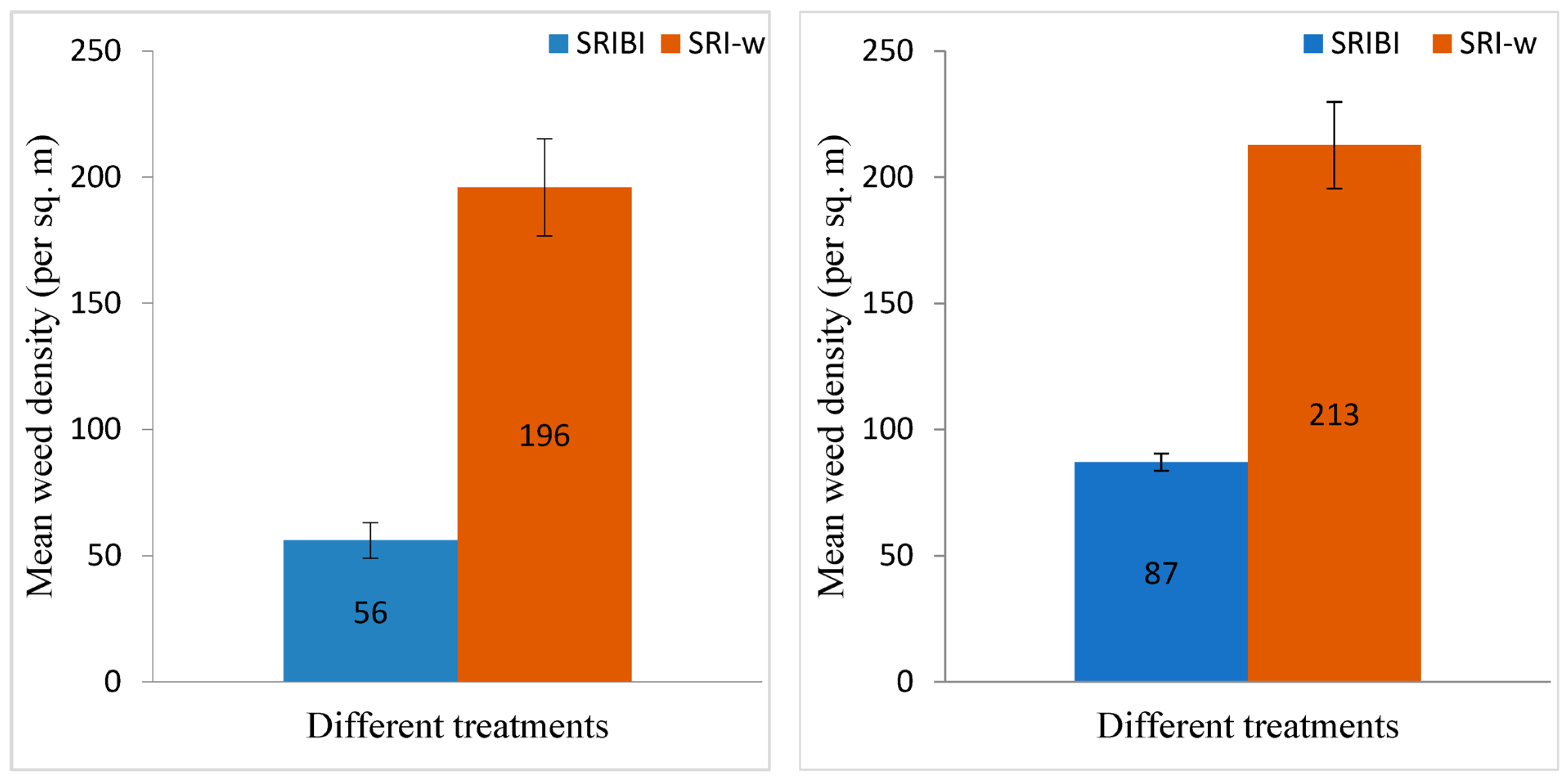
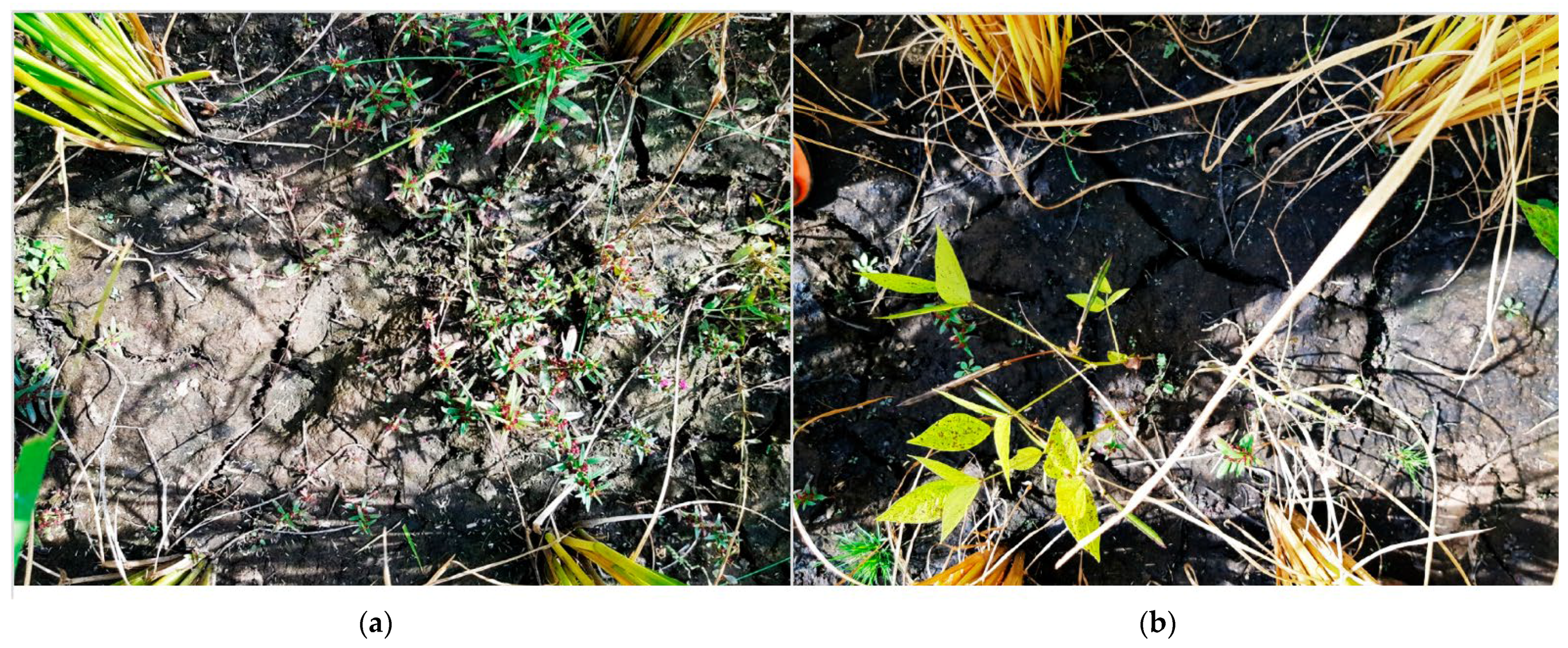
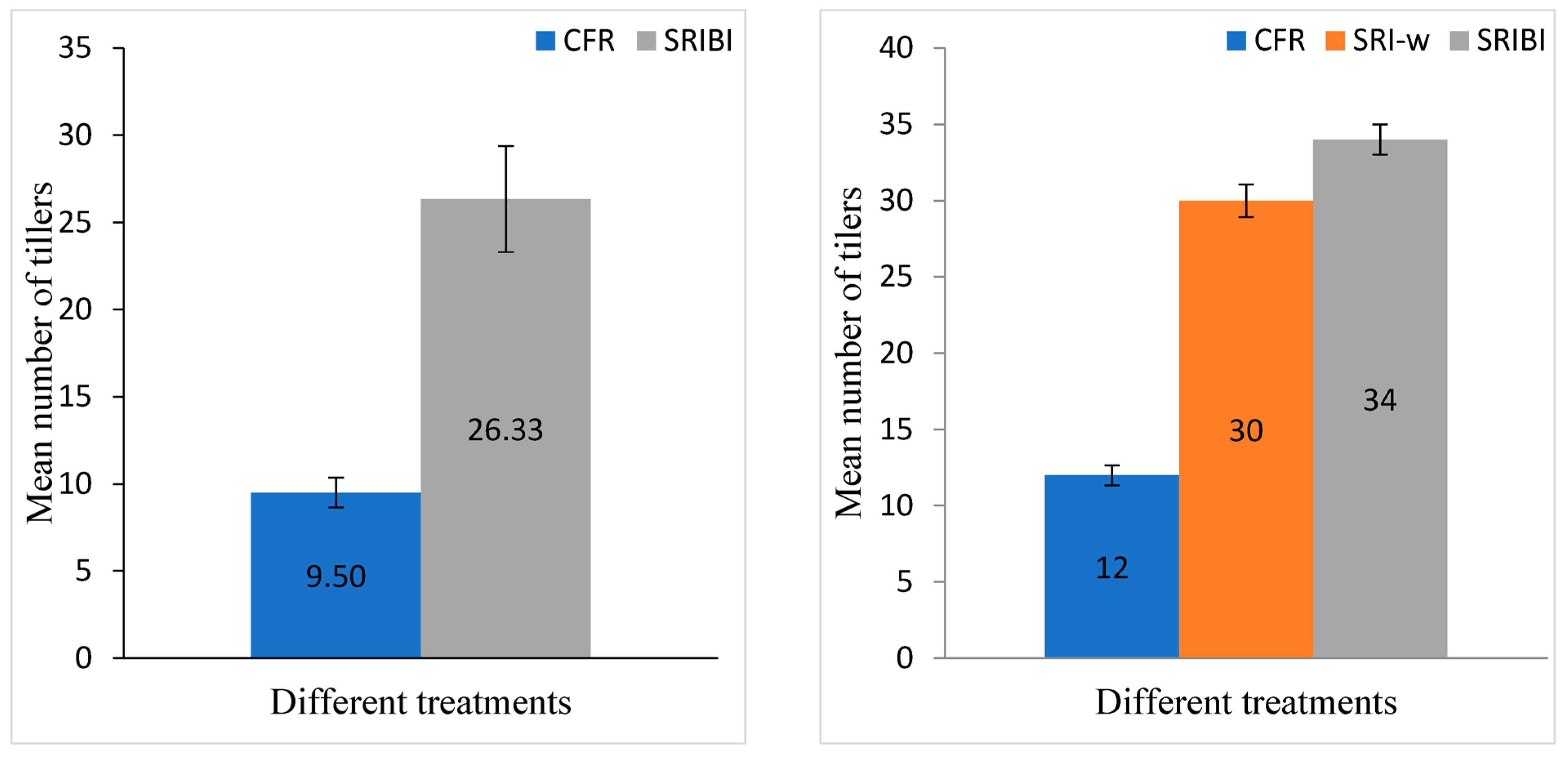
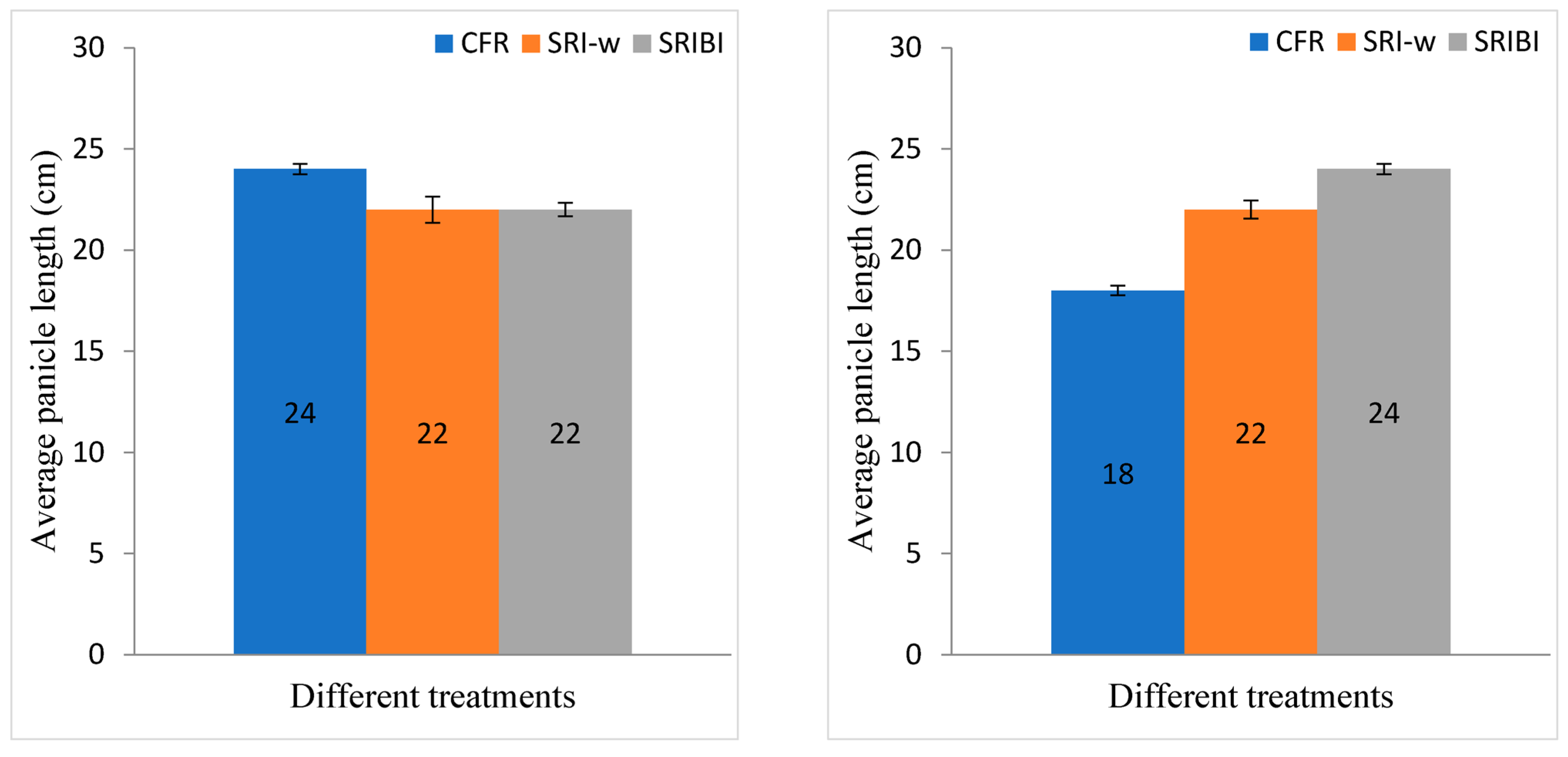
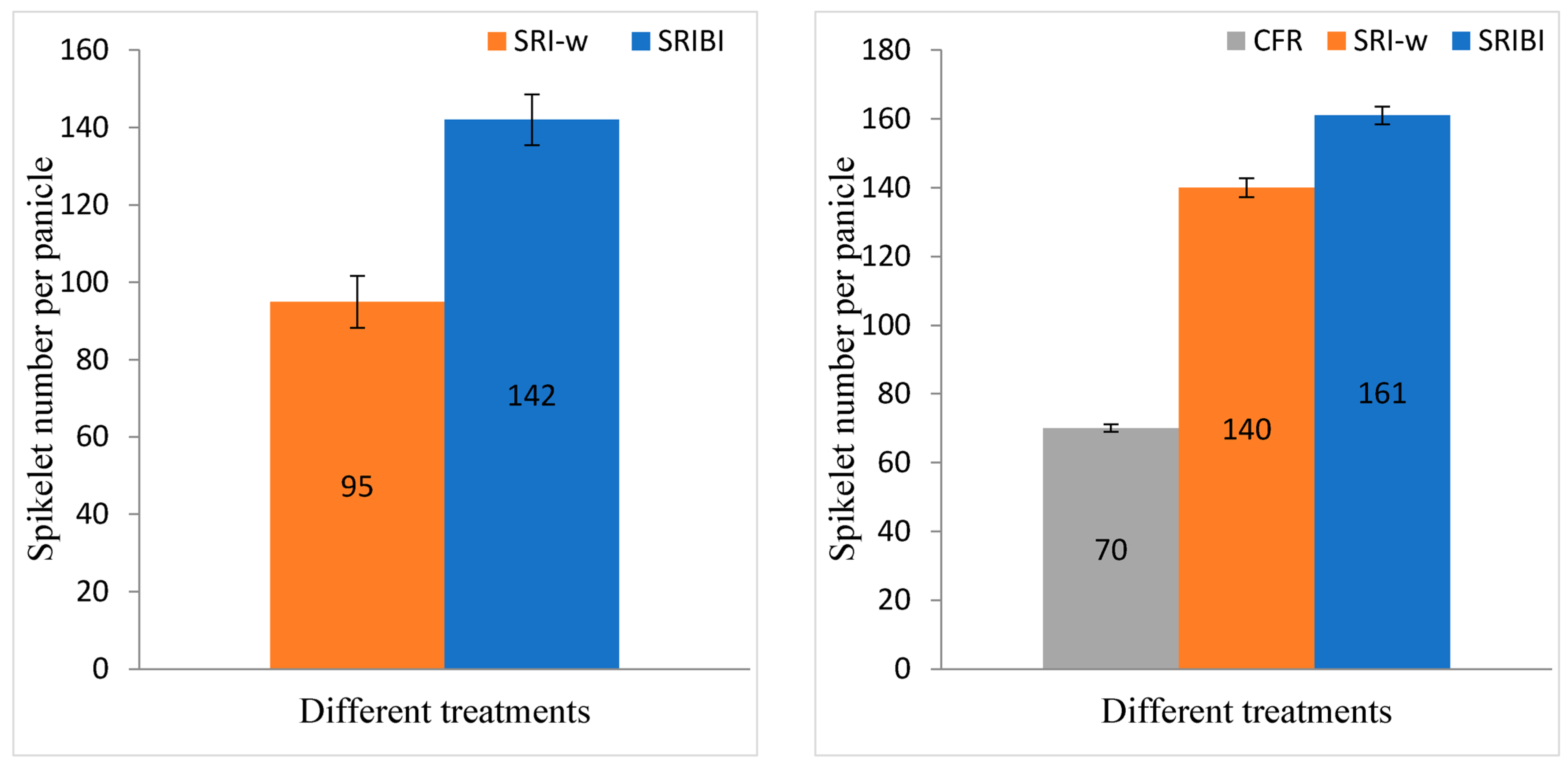
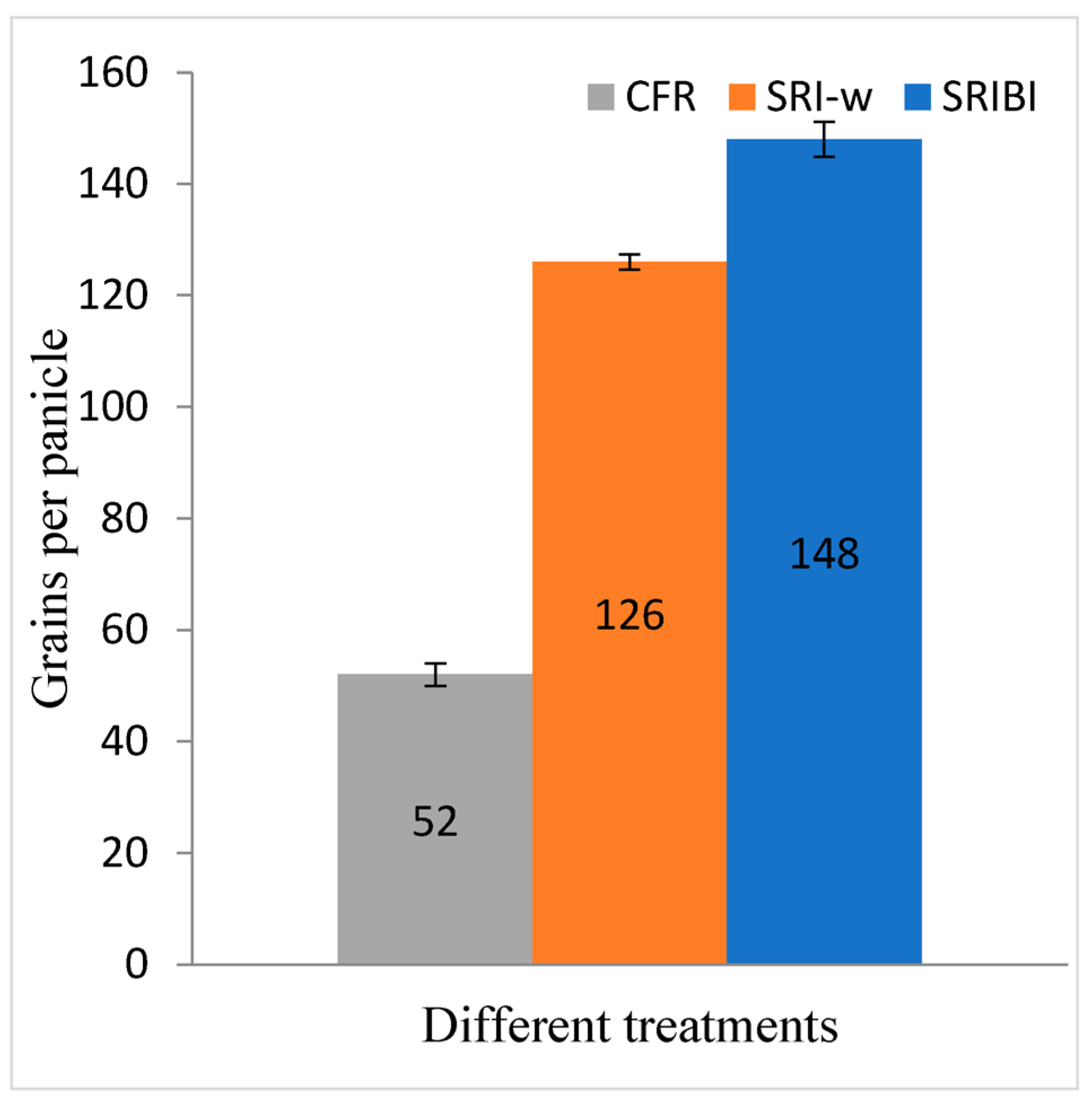

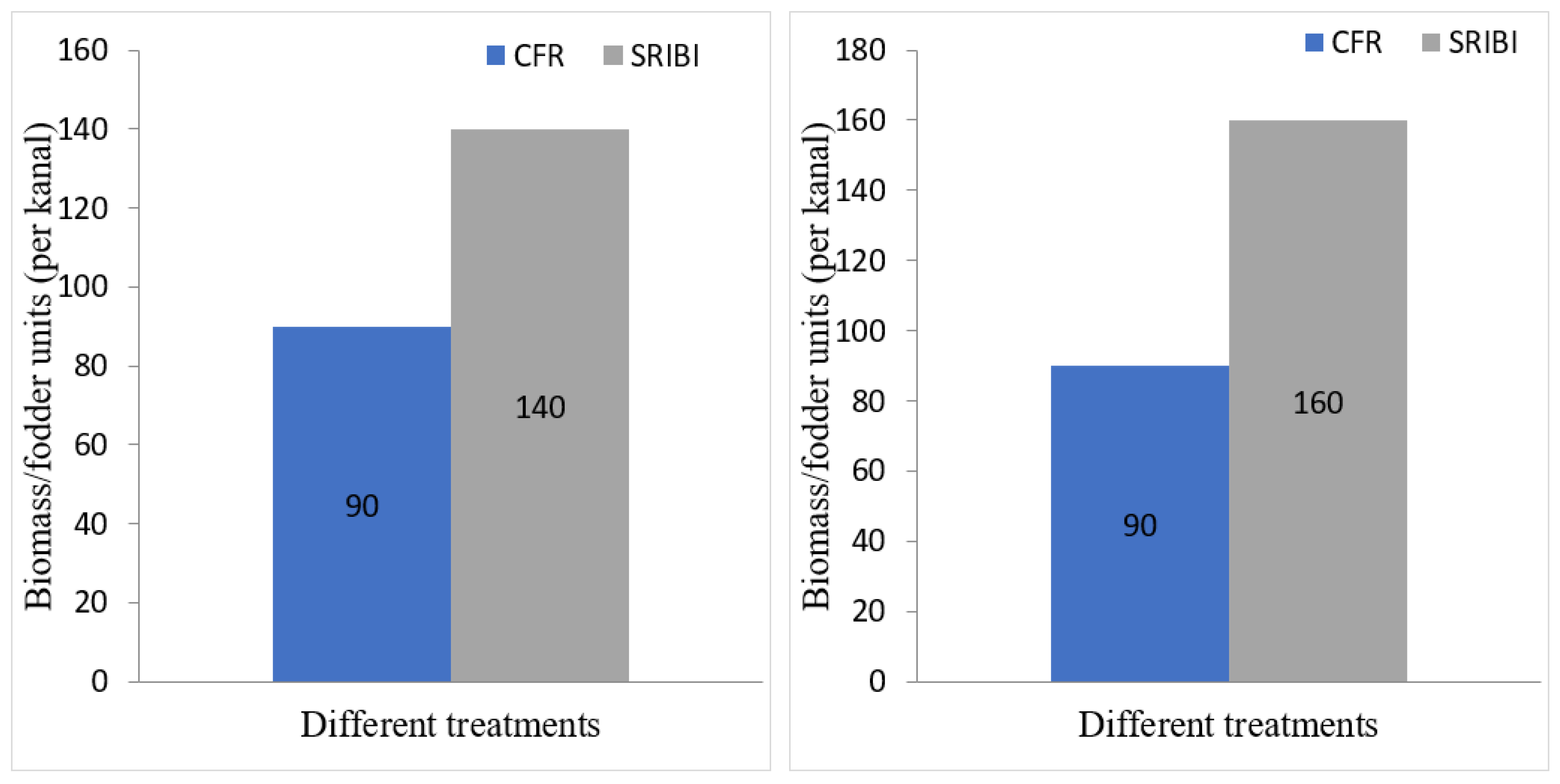
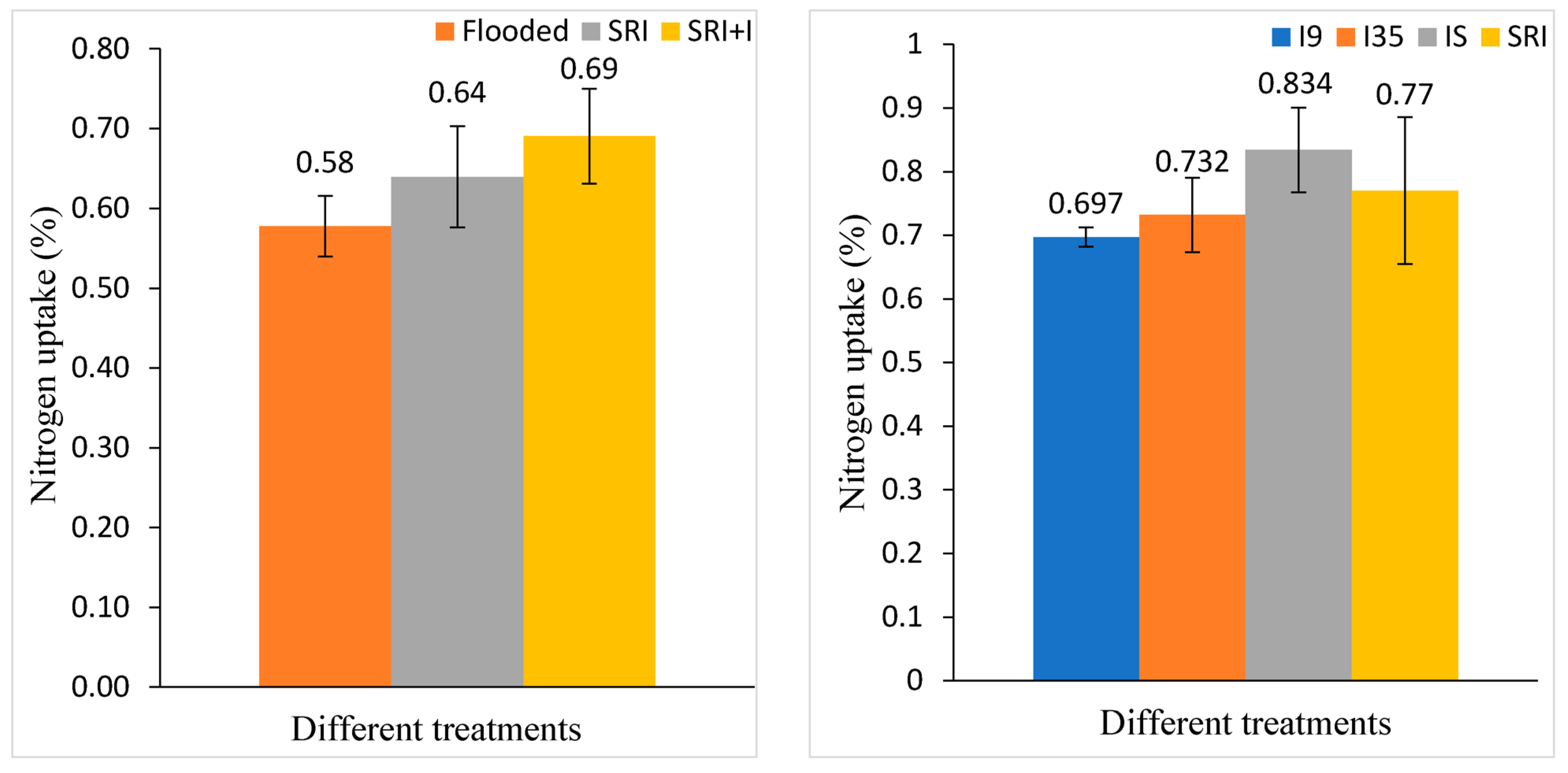

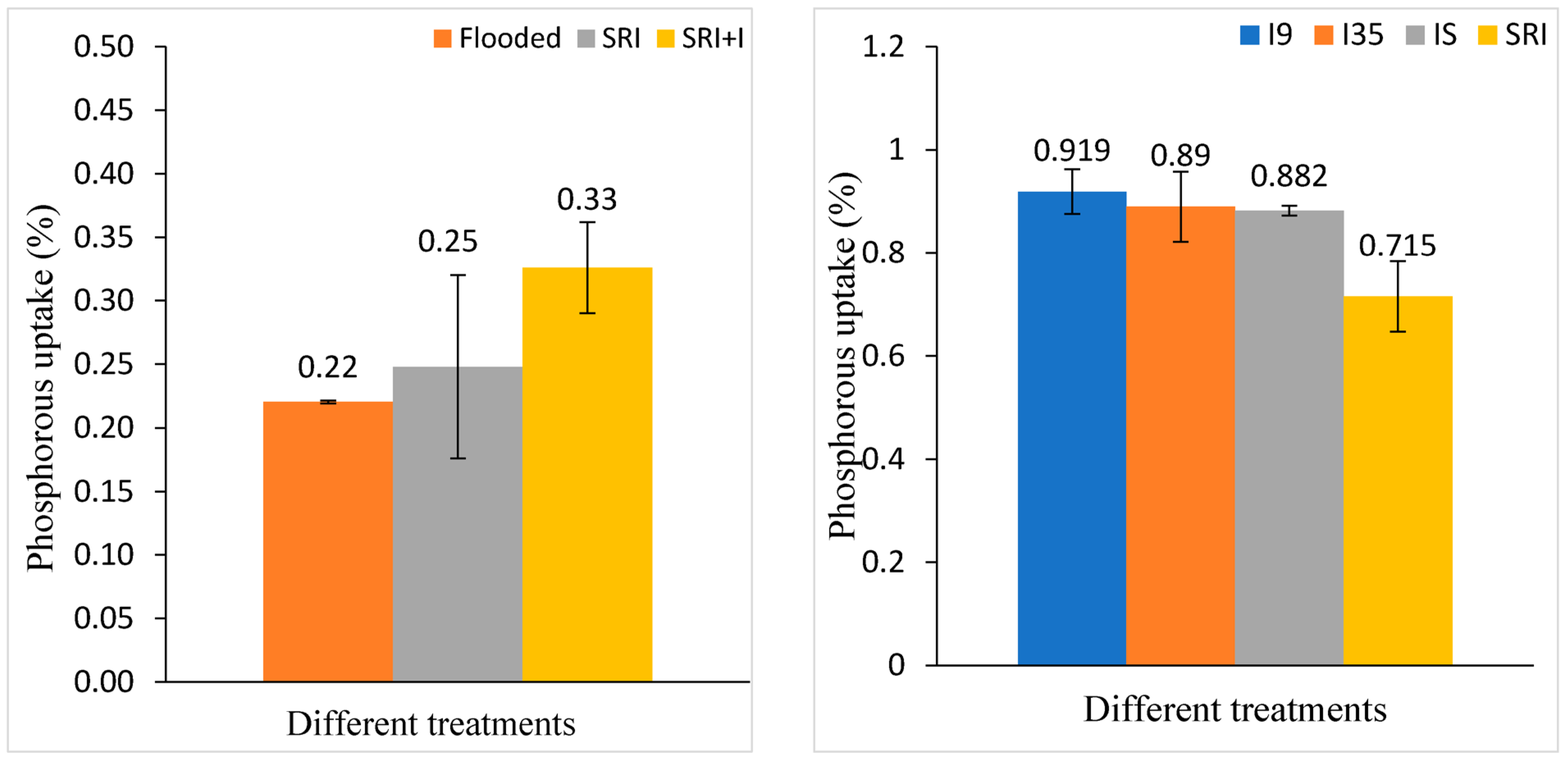
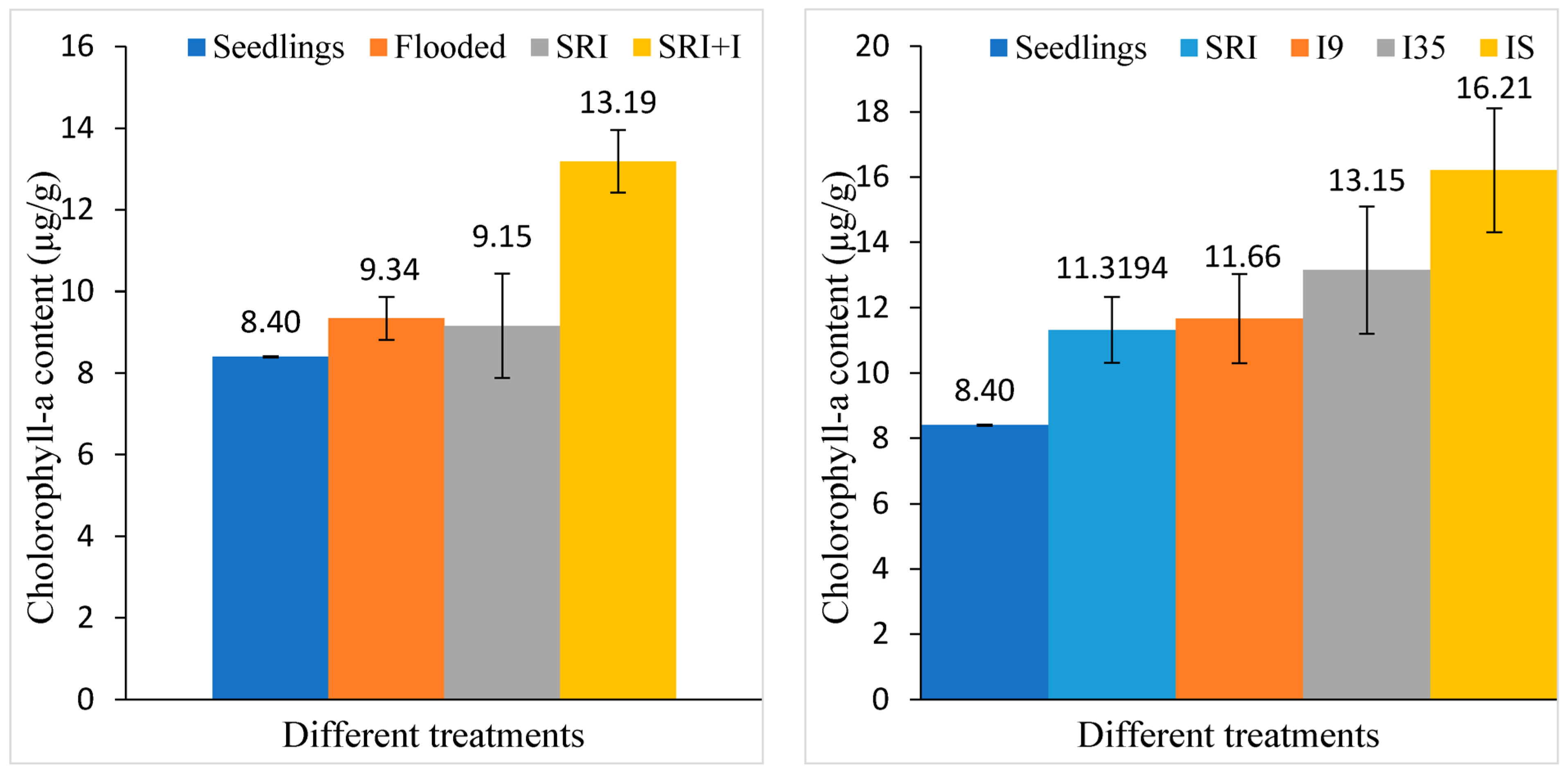
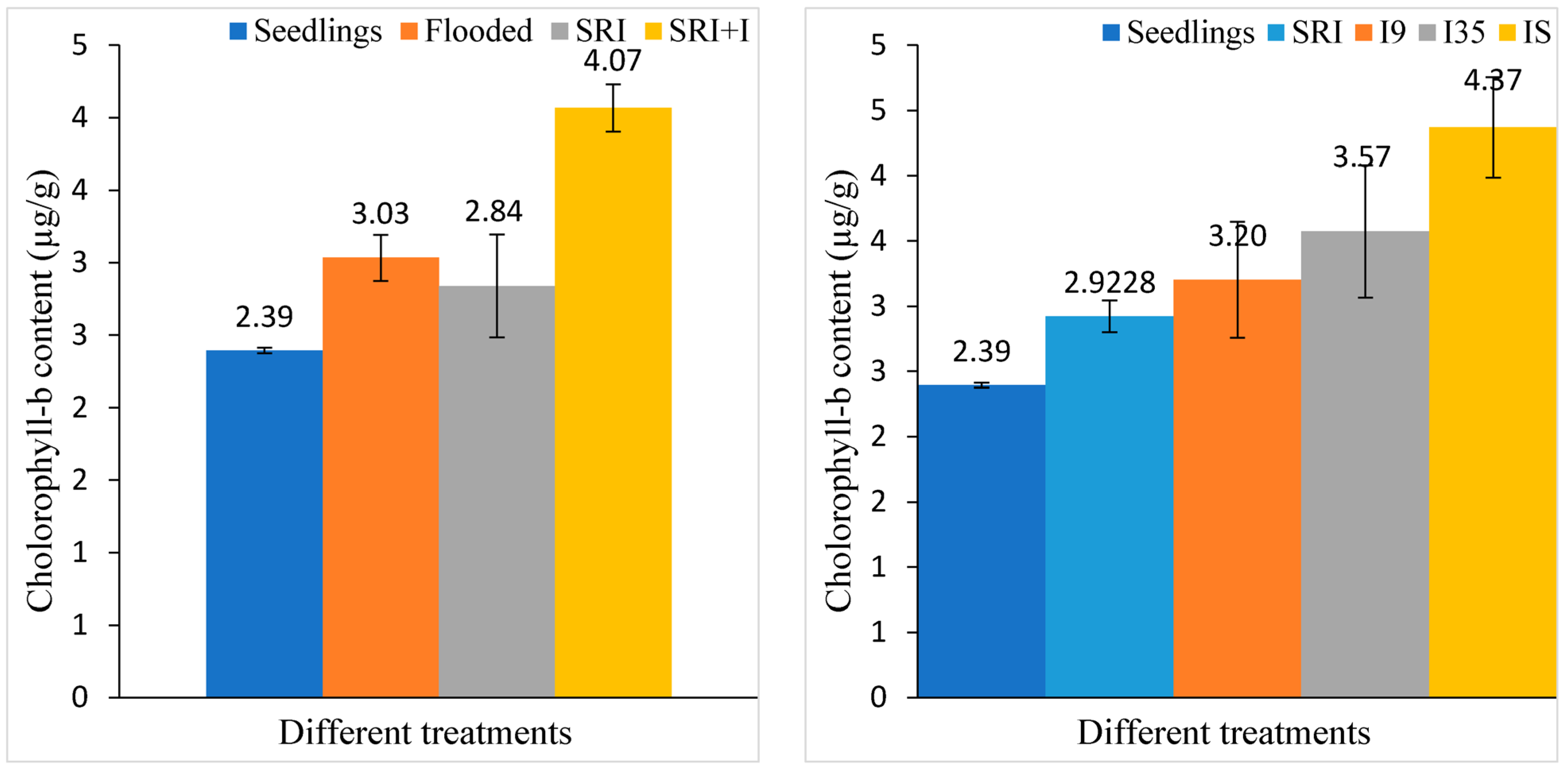
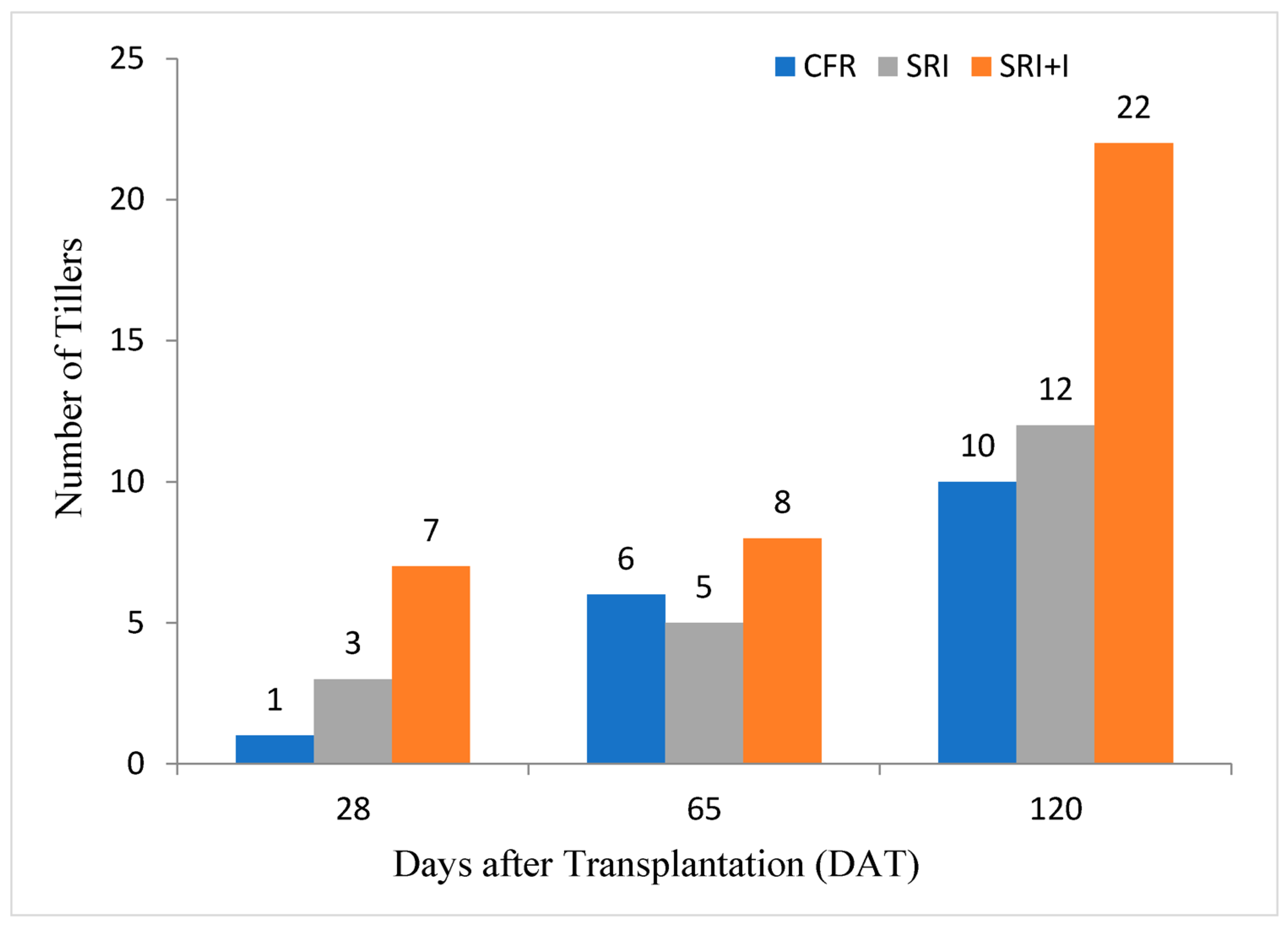
| Practice\System | SRI | SRI-w (Weedy Control) | SRIBI |
|---|---|---|---|
| Early Transplanting | Yes | Yes | Yes |
| Wide Spacing | Yes | Yes | Yes |
| One Plant per Hill | Yes | Yes | Yes |
| Compost Application | Yes | Yes | Yes |
| Alternate Wetting and Drying | Yes | Yes | Yes |
| Frequent Weeding | Yes | No | No |
| Intercropping | No | No | Yes |
| Weed Density | 2019 SRI-w vs. SRIBI | 2020 SRI-w vs. SRIBI | ||||||
|---|---|---|---|---|---|---|---|---|
| p-value | F-value | Fcritical | DF | p-value | F-value | Fcritical | DF | |
| 0.0048 | 14.96 | 5.32 | (1,8) | 0.0001 | 51.81 | 4.74 | (1,12) | |
| Index | Crop Management System | ||
|---|---|---|---|
| CFR | SRI-w | SRIBI | |
| Maximum height (cm) | 136 | 125 | 148 |
| Mean height (cm) | 125 | 119 | 128 |
| Index | Crop Management System | ||
|---|---|---|---|
| CFR | SRI-w | SRIBI | |
| Maximum height (cm) | 102 | 106 | 112 |
| Mean height (cm) | 101 | 104 | 109 |
| Plant Height | 2019 SRI-w vs. SRIBI | 2020 CFR vs. SRI-w vs. SRIBI | ||||||
|---|---|---|---|---|---|---|---|---|
| p-value | F-value | Fcritical | DF | p-value | F-value | Fcritical | DF | |
| 0.05 | 4.50 | 4.49 | (1,14) | 0.0001 | 35.73 | 3.88 | (2,12) | |
| Post hoc analysis | ||||||||
| Qcritical | AMDCFR/SRI | AMDSRI/SRIBI | AMDCFR/SRIBI | |||||
| 4.72 | 3 | 5.8 | 8.8 | |||||
| Tiller Number | 2019 SRI-w vs. SRIBI | 2020 CFR vs. SRI-w vs. SRIBI | ||||||
|---|---|---|---|---|---|---|---|---|
| p-value | F-value | Fcritical | DF | p-value | F-value | Fcritical | DF | |
| 0.0001 | 32.49 | 4.75 | (1,12) | 0.0001 | 160 | 3.56 | (2,18) | |
| Post hoc analysis | ||||||||
| Qcritical | AMDCFR/SRI | AMDSRI/SRIBI | AMDCFR/SRIBI | |||||
| 8.12 | 17.86 | 4.14 | 22 | |||||
| Panicle Length | 2019 SRI-w vs. SRIBI | 2020 CFR vs. SRI-w vs. SRIBI | ||||||
|---|---|---|---|---|---|---|---|---|
| p-value | F-value | Fcritical | DF | p-value | F-value | Fcritical | DF | |
| 0.0649 | 3.12 | 3.35 | (2,7) | 0.0001 | 85 | 3.56 | (2,18) | |
| Post hoc analysis | ||||||||
| Qcritical | AMDCFR/SRI | AMDSRI/SRIBI | AMDCFR/SRIBI | |||||
| 0.89 | 3.93 | 2 | 5.93 | |||||
| SNPP | 2019 SRI-w vs. SRIBI | 2020 CFR vs. SRI-w vs. SRIBI | ||||||
|---|---|---|---|---|---|---|---|---|
| p-value | F-value | Fcritical | DF | p-value | F-value | Fcritical | DF | |
| 0.0001 | 25.31 | 4.49 | (1,16) | 0.0001 | 329.80 | 3.40 | (2,24) | |
| Post hoc analysis | ||||||||
| Qcritical | AMDCFR/SRI | AMDSRI/SRIBI | AMDCFR/SRIBI | |||||
| 70.46 | 70.55 | 18.11 | 88.66 | |||||
| Grains Per Panicle | CFR vs. SRI-w vs. SRIBI | |||
|---|---|---|---|---|
| p-value | F-value | Fcritical | DF | |
| 0.0001 | 383 | 3.47 | (2,21) | |
| Post hoc analysis | ||||
| Qcritical | AMDCFR/SRI | AMDSRI/SRIBI | AMDCFR/SRIBI | |
| 65.43 | 73.5 | 21.625 | 95.125 | |
| Input | Quantity (per ha) | Cost (INR) | Output | Quantity (per ha) | Benefit (INR) | Earnings (INR) | Increase (%) | |
|---|---|---|---|---|---|---|---|---|
| CFR | Seeds | 400 kg | 6000 | Rice | 5600 kg | 84,000 | ||
| Manure | 0.33 trolley | 20,000 | Fodder (Rice Straw) | 1800 units | 72,000 | |||
| Fertilizer | 300 kg | 6666 | ||||||
| Pesticides | n.d. | 4000 | ||||||
| Labour for weeding | 80 work hours | 5000 | ||||||
| Labour for irrigation | 200 work hours | 12,500 | ||||||
| Total cost | 54,166 | Total benefit | 156,000 | 101,834 | ||||
| SRIBI | Seeds | 40 kg | 600 | Rice | 7200 kg | 108,000 | ||
| Manure | 0.33 trolley | 20,000 | Fodder (Rice Straw) | 3200 units | 128,000 | |||
| Compost | 6000 kg | 48,000 | ||||||
| Intercrop Seeds | 2 kg | 400 | ||||||
| Labour for weeding | 10 work hours | 660 | ||||||
| Labour for watering | 100 work hours | 6260 | ||||||
| Total cost | 75,920 | Total benefit | 236,000 | 160,080 | 57.20 | |||
| Chlorophyll Content | Chlorophyll-a SRI vs. SRIBI | Chlorophyll-b SRI vs. SRIBI | ||||||
|---|---|---|---|---|---|---|---|---|
| p-value | F-value | Fcritical | DF | p-value | F-value | Fcritical | DF | |
| 0.05 | 7.39 | 7.70 | (1,4) | 0.035 | 9.87 | 7.71 | (1,4) | |
Publisher’s Note: MDPI stays neutral with regard to jurisdictional claims in published maps and institutional affiliations. |
© 2021 by the authors. Licensee MDPI, Basel, Switzerland. This article is an open access article distributed under the terms and conditions of the Creative Commons Attribution (CC BY) license (https://creativecommons.org/licenses/by/4.0/).
Share and Cite
Shah, T.M.; Tasawwar, S.; Bhat, M.A.; Otterpohl, R. Intercropping in Rice Farming under the System of Rice Intensification—An Agroecological Strategy for Weed Control, Better Yield, Increased Returns, and Social–Ecological Sustainability. Agronomy 2021, 11, 1010. https://doi.org/10.3390/agronomy11051010
Shah TM, Tasawwar S, Bhat MA, Otterpohl R. Intercropping in Rice Farming under the System of Rice Intensification—An Agroecological Strategy for Weed Control, Better Yield, Increased Returns, and Social–Ecological Sustainability. Agronomy. 2021; 11(5):1010. https://doi.org/10.3390/agronomy11051010
Chicago/Turabian StyleShah, Tavseef Mairaj, Sumbal Tasawwar, M. Anwar Bhat, and Ralf Otterpohl. 2021. "Intercropping in Rice Farming under the System of Rice Intensification—An Agroecological Strategy for Weed Control, Better Yield, Increased Returns, and Social–Ecological Sustainability" Agronomy 11, no. 5: 1010. https://doi.org/10.3390/agronomy11051010
APA StyleShah, T. M., Tasawwar, S., Bhat, M. A., & Otterpohl, R. (2021). Intercropping in Rice Farming under the System of Rice Intensification—An Agroecological Strategy for Weed Control, Better Yield, Increased Returns, and Social–Ecological Sustainability. Agronomy, 11(5), 1010. https://doi.org/10.3390/agronomy11051010






